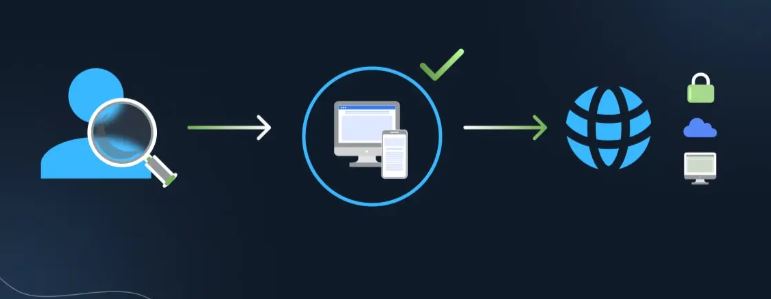Introduction to Zero Trust Security
Zero-trust security represents an advanced and systematic approach compared to traditional security methods. This traditional security method operates on the never trust and always verify method. Unlike the dependency on traditional security methods, it offers parameters such as firewalls, VPNs, antivirus software, and other security requirements. Zero-trust security focuses on both the outside and inside of the network. As there is an evolution of cyber threats in the current world, hackers are developing proactive defenses toward the organizations (Mylavarapu, 2024). Correspondingly, zero-trust security enhances security protocols to work against cyber threats. The approach helps in eliminating the critical vulnerabilities, addresses overall security postures to the business, and manages the risks.
Principles of Zero Trust Security
Continuous monitoring and validation
In this case, the resources should continuously monitor the abnormal activities. Both authentication and authorization of users are based on elements and data points such as location, user identity, data sensitivity, workload, and services. To make sure of strong identification of validation, authentication, and assessment of device health. There is a perfect recommendation of users’ identity and application integrity towards maintenance.
Enforcing least privilege access
The principle of least privilege ensures that users have only minimum access to the applications and necessary role. This is achieved with the application of access controls such as just-in-time, risk-based, just-enough access, and adaptable policies of civil services that support productivity and security. These help limit the potential risk from insider threats and also compromised accounts,
Assuming breach
The zero-trust model operates on the premise that security features are unavoidable. These breaches can come from internal threats or external threats. The goal of zero trust is to limit the potential damage if a breach happens (Ike, et al., 2021). This is achieved with policies such as end-to-end encryption, micro segmentation, and constant monitoring of unusual patterns and behaviors. Moreover, having strong incident response systems and strategic recovery helps in managing the breaches.
Zero Trust Security

Benefits of Zero Trust Security
Securing remote and distributed workforces
Generally, zero-trust security is an essential approach for present remote systems. It ensures that users are authenticated based on the access request and their identity towards the connections. Various sectors such as home networks, public Wi-Fi, and corporate offices need secured systems. Moreover, this ensures flexibility towards secured mechanisms from various locations.
Simplify access with single sign-on
The incorporation of single sign-on aligns with user roles and integrates multi-factor authentication. The zero-trust security simplifies the user experience and needs frequent logins. In addition, it reduces continuous authentication prompts and allows users to focus more on their tasks. Also, this streamlined access produces a secured mechanism toward critical systems and applications.
Comprehensive monitoring and threat analytics
Zero trust security offers unified threat visibility from various security tools. It considers various signals from user activities, environmental rates, and data and device behaviors (Kannan, 2022). Moreover, these platforms ensure centralized visibility, which helps security teams to detect unusual activities and react to them proactively.
Robust protection against multiple threats
Employees a layered security which approaches encryption and micro segmentation. These multiple defenses create overlapping barriers against threats such as compromised identities, malware, and unauthorized access to the network. This mighty face protection ensures that even if one defense is breached, other players are also affected.
Zero Trust Network Access

Use cases
Multi-cloud security
Generally, multi-cloud security zero trust is a highly effective method in the secured mechanism of the hybrid environment. Since zero trust focuses on the identity-based system, only verified cloud workloads are accessible. No matter the source or changes in IT infrastructure, zero trust consists of a cloud environment with safe transactions in strict authentication protocol.
Supply chain security
Basically, organizations need third-party vendors and contractors to access the network. However, this creates an effective vulnerability that exploits the supply chain (Lindemulder & Kosinski, 2024). With zero trust, there is a continuous adoption of least privilege access and maintaining the services without any risk of attack.
IOT device visibility
Devices due to the Internet connectivity exposed towards security risk. The hackers often get targets to include the system with vulnerable attacks. The zero test continuously monitors the health and status of the system. In this case, each device is monitored with accessibility control and encryption techniques towards the network resources.
Future of Zero-Trust Security Against Cyber Threats
The integration of artificial intelligence and machine learning into zero-trust security systems is a major step toward cloud security. Moreover, these technologies help in improving the responses, threat detection, and adaptation to new threats by adopting zero trust principles. The artificial intelligence helps in observing the unusual user behavior that suggests a compromised account. Machine learning algorithms spot patterns of abnormal behaviors from unknown locations (Nzeako & Shittu, 2024). These models access factors such as time, device, and location to decide the authentication of the user. This provides high security towards the adaptation, and it needs multi-factor authentication. Furthermore, AI predicts threats by analyzing past incidents and allows the teams to act early. It allows quick decisions towards security threats, such as resetting passwords and compromised devices without the intervention of humans.
Conclusion
The zero trust security towards cyber threats is an effective advancement in safeguarding the organization against cyber criminals. Focusing on the verification of least privilege access and assumption of potential breaches helps in secured mechanism. This also offers a defense mechanism against both external and internal threats. In summary, the principles of zero trust, such as continuous monitoring, assuming beach, and various techniques, help in mitigating the strategies. Additionally, the integration of machine learning and artificial intelligence involves zero trust systems for threat detection and staying ahead to evolve the threats. The future of zero security is increasing with the ability to demand for facing new challenges and predicting the potential risks in advance.
References
Ike, C. C., Ige, A. B., Oladosu, S. A., Adepoju, P. A., Amoo, O. O., & Afolabi, A. I. (2021). Redefining zero trust architecture in cloud networks: A conceptual shift towards granular, dynamic access control and policy enforcement. Magna Scientia Advanced Research and Reviews, 2(1), 074–086. Retrieved from https://magnascientiapub.com/journals/msarr/sites/default/files/MSARR-2021-0032.pdf
Kannan, Y. (2022). Zero Trust Architecture: Principles, Implementation, and Impact on Organizational Security. International Journal of Science and Research (IJSR), 11(05), 2111-2118. Retrieved from https://www.ijsr.net/archive/v11i5/SR24716003250.pdf
Lindemulder, G., & Kosinski, M. (2024, Jun 20). What is zero trust? Retrieved from IBM: https://www.ibm.com/think/topics/zero-trust
Mylavarapu, S. (2024). The Zero Trust Security Model and Cybersecurity in the Industries. Journal of Student Research, 13(01), 1-10. Retrieved from https://www.researchgate.net/publication/382674297_The_Zero_Trust_Security_Model_and_Cybersecurity_in_the_Industries
Nzeako, G., & Shittu, R. A. (2024). Implementing zero trust security models in cloud computing environments. World Journal of Advanced Research and Reviews, 24(03), 1647-1660. Retrieved from https://wjarr.com/sites/default/files/WJARR-2024-3500.pdf
Keywords
Multi-cloud security, Antivirus, Zero-trust security, Secured mechanisms, Cyber attacks
Relevant Articles
Passwordless and Biometric Authentication: The Next Frontier in Digital Security
Ransomware Threats: How Businesses Can Stay Secure
Read More about the Topic
Zero Trust Security: Reimagining Cyber Defense for Modern Organizations
Revolutionizing cyber security: The role of zero trust in modern defense strategies
